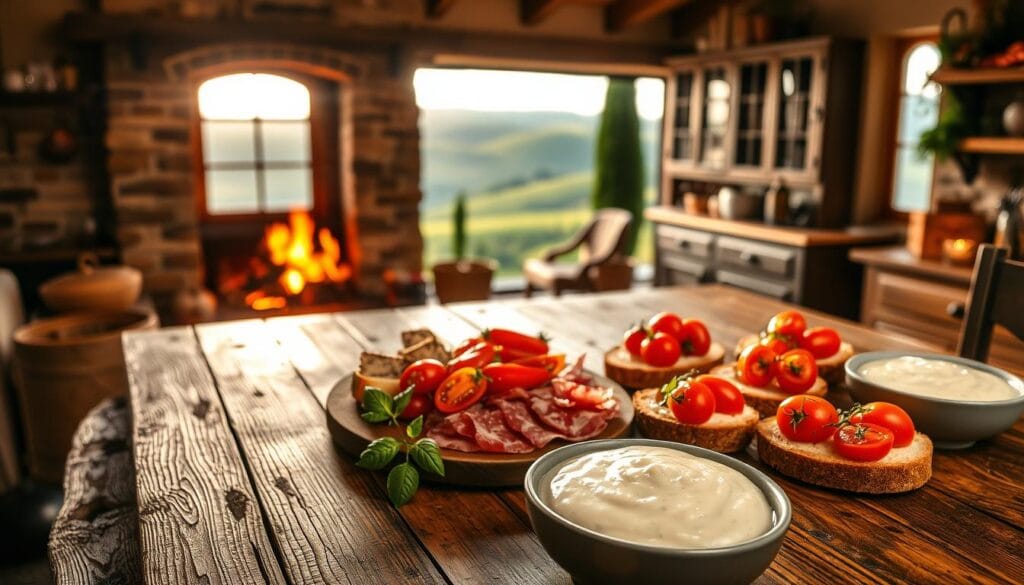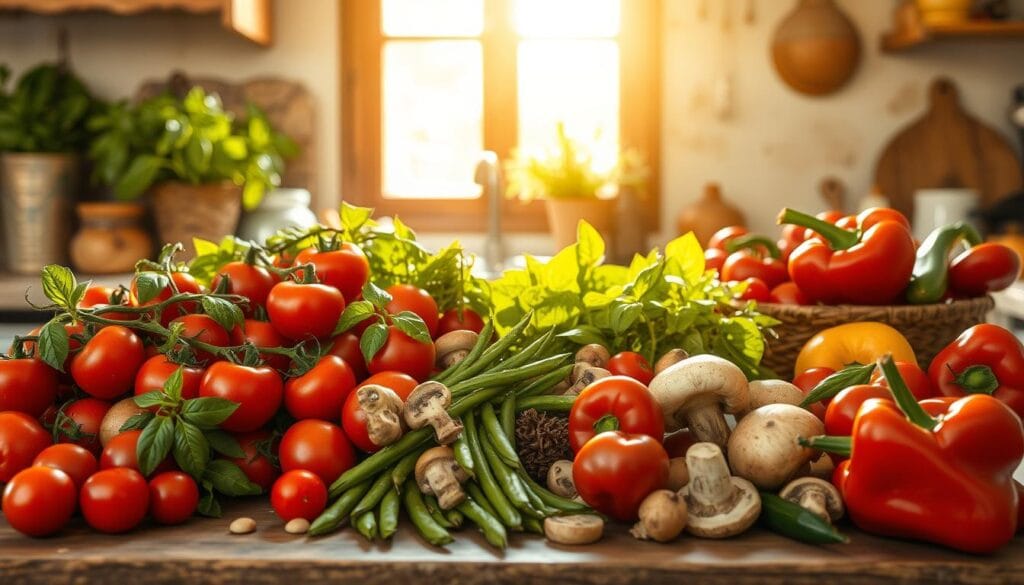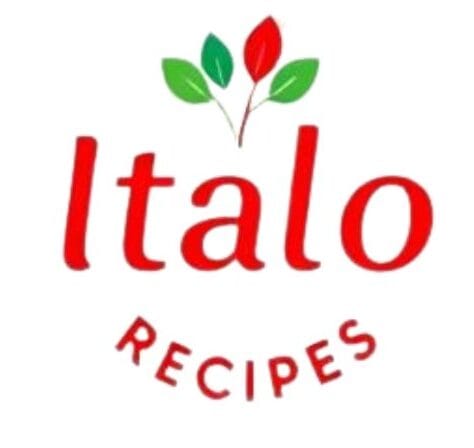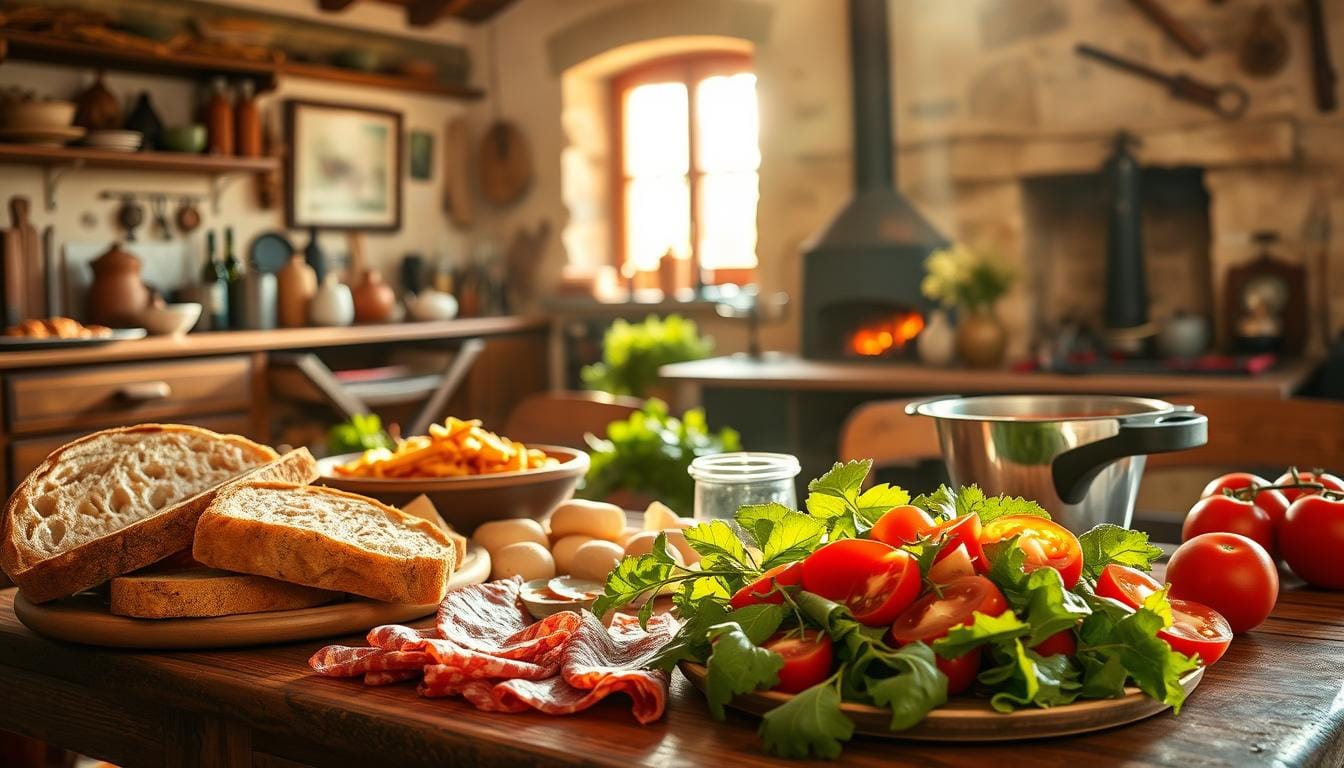What to eat in Tuscany in 2025? Guide to typical dishes and homemade recipes
What to eat in Tuscany?Imagine walking through the hills of Tuscany. You’re surrounded by old cities and vineyards. The smell of fresh bread fills the air. It’s a dream for anyone who loves food.
Tuscan cuisine is simple yet full of flavor. It uses local, seasonal ingredients. This mix of old recipes and new ideas makes eating here special.
As you explore, you’ll find a world of tastes. You’ll love the hearty soups and the fancy pasta dishes. Tuscan cooking will make your senses happy.
Table of Contents
Key Takeaways
- Experience the simplicity and richness of Tuscan cuisine
- Discover traditional Tuscan dishes with modern twists
- Explore the region’s focus on locally sourced, seasonal produce
- Indulge in hearty soups and exquisite pasta dishes
- Enjoy the unique gastronomic experience that Tuscany has to offer
The Culinary Heritage of Tuscany: Past, Present and Future
Exploring Tuscany’s food scene reveals a blend of tradition and innovation. Here, simplicity is key. The region’s cuisine is known for its quality ingredients, seasonal produce, and old techniques.
The Philosophy of Simple, Quality Ingredients
Tuscan food philosophy is simple: great meals don’t need to be complicated. It focuses on quality ingredients and seasonal eating. This approach makes dishes both simple and deep.
How Traditional Methods Are Being Preserved in 2025
In 2025, Tuscany keeps its traditional cooking alive. It does this through agriturismo, cooking classes, and farm-to-table projects. These efforts keep the region’s food heritage alive while also supporting sustainability.
The Slow Food Movement’s Influence on Modern Tuscan Cuisine
The Slow Food Movement has shaped modern Tuscan food. It promotes local food systems, saves traditional recipes, and uses native ingredients. This movement celebrates the region’s culinary variety and deepens love for cuisine toscane.
Tuscany’s rich food heritage inspires food enthusiasts globally. It offers les meilleurs plats de toscane, like hearty ribollita and exquisite cantucci.
What to Eat in Tuscany: 10 Must-Try Traditional Dishes
Tuscany’s food scene is a treasure trove of flavors. It’s all about simple, hearty dishes made from local ingredients. There’s a wide variety to try.
Bread-Based Classics: Pappa al Pomodoro and Ribollita
Tuscan food is known for its bread dishes. Pappa al Pomodoro and Ribollita are two favorites. Pappa al Pomodoro is a tomato and bread soup, made with stale bread and fresh tomatoes. Ribollita is a thick soup with vegetables, bread, and cannellini beans, topped with olive oil.
These dishes show Tuscan cooking’s heart: turning simple ingredients into something delicious. You can make them at home with fresh, local ingredients.
Other Must-Try Dishes
Tuscany has more than just bread dishes. Pappardelle al Cinghiale is a must-try. It’s wide pasta with a wild boar ragù. The boar’s rich flavor pairs well with the pasta, making it unforgettable.
Bistecca alla Fiorentina is another classic. It’s a thick T-bone steak, grilled rare. This dish shows Tuscan love for quality meat and simple cooking.
Pici is hand-rolled pasta with various sauces. It’s often with a meat ragù or a garlic and tomato sauce. Pici highlights the region’s pasta traditions.
Don’t miss Finocchiona, a fennel-flavored salami, and Pecorino Toscano, a tangy sheep’s milk cheese. These are key in Tuscan cuisine, enjoyed as snacks or in recipes.
« Tuscan cuisine is not just about the food; it’s about the culture, the tradition, and the love that goes into every dish. »
Exploring Tuscany’s food scene is like learning its history and culture. Whether it’s a simple Pappa al Pomodoro or a rich Bistecca alla Fiorentina, you’re tasting Tuscany’s heritage.
Regional Culinary Map: Specialties Across Tuscany’s Provinces
Tuscany’s provinces are a feast for the senses, with flavors ranging from urban to coastal. Travelers find that locals take great pride in their food heritage. Many dishes in Tuscany proudly highlight their origins.
Florence and Prato: Urban Delicacies
Florence, Tuscany’s capital, is known for its refined dishes. The Bistecca alla Fiorentina, a thick T-bone steak, is a must-try. Prato, meanwhile, is celebrated for Cantucci con Vin Santo, almond biscuits enjoyed with Vin Santo wine.
Siena and Arezzo: Rustic Inland Flavors
Siena and Arezzo, in Tuscany’s heart, serve up hearty dishes. Siena’s Pici all’Aglione is a hand-rolled pasta with rich tomato sauce. Arezzo is famous for Cinghiale, a wild boar stew.
Coastal Treasures: Seafood from Livorno and Grosseto
Livorno and Grosseto, on the coast, are known for their seafood. Livorno’s Cacciucco is a fish stew. Grosseto’s Seppie al nero is cuttlefish in their own ink, often with polenta.
Lucca and Pistoia: Northern Tuscan Specialties
Lucca and Pistoia, in northern Tuscany, have their own culinary traditions. Lucca is famous for Torta di Lucca and Farro soup. Pistoia is known for its Vegetable Soup and Castagnaccio, a chestnut flour cake.
| Province | Specialty Dish | Description |
|---|---|---|
| Florence | Bistecca alla Fiorentina | T-bone steak grilled over an open flame |
| Siena | Pici all’Aglione | Hand-rolled pasta with rich tomato sauce |
| Livorno | Cacciucco | Fish stew made with a variety of seafood |
| Lucca | Torta di Lucca | Rich, dense cake |
Tuscan Home Cooking: Authentic Recipes to Master

To truly experience Tuscan cuisine, you need to master its authentic recipes at home. Tuscan home cooking is simple, uses quality ingredients, and follows traditional methods. By embracing these principles, you can bring the essence of Tuscany into your kitchen.
Starter Recipes: Perfect Panzanella and Crostini Toscani
Starting your meal with authentic Tuscan starters is a great way to appreciate the region’s culinary delights. Panzanella, a bread and tomato salad, is a classic. You’ll need stale bread, fresh tomatoes, onions, and basil, all dressed with olive oil and vinegar. Crostini Toscani, on the other hand, are toasted bread slices topped with a variety of ingredients such as liver pâté or chicken liver mousse.
Main Course Recipes: Homemade Pici and Peposo Beef Stew
For the main course, consider making Pici, a hand-rolled pasta dish typically served with a hearty ragù made from tomatoes and meat. Another option is Peposo, a beef stew originating from the Renaissance period, characterized by its rich flavor and tender beef.
Dessert Recipes: Cantucci Biscuits and Castagnaccio
No Tuscan meal is complete without dessert. Cantucci are almond biscuits traditionally dipped in Vin Santo, a sweet dessert wine. Castagnaccio, a chestnut flour cake, is another beloved dessert, often flavored with rosemary and pine nuts.
Tips for Authentic Flavor Profiles
Achieving authentic Tuscan flavors involves using high-quality, seasonal ingredients and adhering to traditional cooking methods. For instance, using fresh tomatoes for sauces and selecting the right type of olive oil can significantly enhance the flavor of your dishes.
Modern Adaptations for American Kitchens
While traditional methods are essential, you can adapt Tuscan recipes to suit modern American kitchens. For example, using locally sourced ingredients and adjusting portion sizes can make these recipes more accessible and practical for home cooks.
| Recipe | Main Ingredients | Traditional Pairing |
|---|---|---|
| Panzanella | Bread, Tomatoes, Basil | Chianti Classico |
| Pici | Pasta, Meat Ragù | Brunello di Montalcino |
| Cantucci | Almonds, Vin Santo | Vin Santo |
« The discovery of a new dish does more for human happiness than the discovery of a new star. » – Jean Anthelme Brillat-Savarin
Farm-to-Table Renaissance: Sustainable Eating in 2025
In 2025, Tuscany’s food scene is all about sustainable eating. The farm-to-table movement is growing fast. It focuses on organic food, local sources, and new farming ways.
Organic Agriturismo Experiences and Farm Stays
Tuscany’s agriturismos are more than places to stay. They offer a deep dive into local food. In 2025, these stays will teach you about cuisine toscane through hands-on experiences.
You’ll help with tasks like picking olives. Then, you’ll cook meals that are truly Tuscan.
Zero-Kilometer Dining and Local Sourcing
Zero-kilometer dining is big in Tuscany now. Chefs use local ingredients for fresher, truer dishes. This helps farmers and cuts down on food transport’s carbon impact.
When you eat at places that focus on local food, you’ll taste the best of les meilleurs plats de toscane.
Tech-Enhanced Farming Practices Shaping Tuscan Ingredients
Technology is changing Tuscany’s farms for the better. Tools like drones and data help farmers grow better crops. This makes farming more sustainable and helps the local food and environment.
Wine and Dine: The Perfect Tuscan Pairings
Exploring Tuscany’s food scene is exciting. Knowing the right wine pairings makes it even better. Tuscany is known for its tasty dishes and great wines that go well with them.
Red Wines: Chianti Classico, Brunello, and Super Tuscans
Tuscany is famous for its red wines. Chianti Classico is one of the most famous. It goes well with many Tuscan dishes, like Pappardelle al Cinghiale and Bistecca alla Fiorentina.
Brunello di Montalcino is another top red wine. It has complex flavors and ages well. It’s great with richer meat dishes.
Super Tuscans mix traditional Sangiovese with international grapes. They offer a modern twist to Tuscan wines. These wines are bold and pair well with hearty dishes.
White Wines: Vernaccia di San Gimignano and Emerging Varieties
While reds are more common, Vernaccia di San Gimignano is a standout white wine. It’s crisp and refreshing. It’s perfect with seafood and lighter dishes.
New white varieties are also getting attention. They bring a fresh look to Tuscan whites.
Dessert Wines: Vin Santo and Food Pairings
Vin Santo is a traditional Tuscan dessert wine. It has nutty and caramel flavors. It’s often paired with Cantucci, almond biscuits, for a classic treat.
2025 Wine Trends: Biodynamic and Small-Batch Productions
The Tuscan wine scene is changing. There’s more focus on biodynamic and small-batch productions. These wines are made sustainably and showcase Tuscan terroir. They’re delicious and good for the environment.
Learning about wine pairings helps you enjoy Tuscany’s food more. You’ll get the most out of the region’s culinary delights.
Where to Eat: From Michelin Stars to Hidden Trattorias
Tuscany offers a wide range of dining options. You can find Michelin-starred restaurants or cozy trattorias. There’s something for every taste.
Fine Dining Destinations Worth the Splurge
Tuscany boasts many Michelin-starred restaurants. Il Latini in Florence is a top choice. It serves classic Tuscan dishes with a modern twist, using local ingredients.
- Experience the best of Tuscan cuisine at these top-rated restaurants.
- Enjoy innovative dishes crafted by world-renowned chefs.
- Savor the rich flavors and aromas of Tuscany’s culinary heritage.
Authentic Family-Run Restaurants and Osterias
For a traditional meal, try Tuscany’s family-run restaurants and osterias. These places have been passed down through generations. They serve hearty, homemade dishes that highlight the region’s culinary traditions.
La Giostra in Florence is a great example. It offers a warm atmosphere and dishes made with love.
Food Markets and Street Food Experiences
Tuscany’s food markets and street food stalls are perfect for trying local treats. You can find artisanal cheeses and freshly made panini. These places showcase the region’s culinary diversity.
Digital Dining: Apps and Services for Finding Authentic Cuisine in 2025
In 2025, finding authentic Tuscan food is easier than ever. Digital dining apps and services help you find the best local restaurants. You can read reviews and even order food online. This makes enjoying Tuscany’s culinary delights simple, no matter where you are.
- Use dining apps to discover hidden gems and local favorites.
- Read reviews from fellow travelers and locals to find the best places to eat.
- Order traditional Tuscan dishes online and enjoy them from the comfort of your accommodation.
Whether you love food, enjoy casual meals, or are somewhere in between, Tuscany has it all. Explore the region’s culinary delights, from fine dining to family-run eateries and street food.
Seasonal Tuscan Dining Calendar for 2025

Exploring Tuscany’s food scene in 2025 means knowing the seasons. Each time of year brings its own flavors and dishes. This is because the food here is tied to the land and its harvests.
Spring: Artichokes, Fava Beans, and Easter Specialties
Spring in Tuscany is all about fresh food. Artichokes and fava beans are big in the local cuisine. Easter adds its own treats, like torta di riso and cappelletti.
Summer: Tomatoes, Garden Vegetables, and Festive Dishes
Summer is tomato and zucchini season. These veggies star in pappa al pomodoro and ribollita. Summer festivals also bring out special dishes, celebrating Tuscan food traditions.
Fall: Truffles, Mushrooms, Chestnuts, and Olive Oil Harvest
Fall is harvest time in Tuscany. Truffles, mushrooms, and chestnuts are gathered. It’s also when olive oil is pressed, a family affair.
Winter: Game Meats, Hearty Soups, and Holiday Traditions
Winter means heartier food, like game meats and soups. ribollita and pappa al pomodoro are favorites. Holiday meals, like Christmas’s castagnaccio, are also special.
| Season | Key Ingredients | Traditional Dishes |
|---|---|---|
| Spring | Artichokes, Fava Beans | Torta di Riso, Cappelletti |
| Summer | Tomatoes, Garden Vegetables | Pappa al Pomodoro, Ribollita |
| Fall | Truffles, Mushrooms, Chestnuts | Olive Oil, Castagnaccio |
| Winter | Game Meats | Ribollita, Pappa al Pomodoro, Castagnaccio |
By following the Tuscan dining calendar, you can taste the region’s true flavors. Enjoy the freshest ingredients and dishes each season offers.
Conclusion: Embracing the Timeless Appeal of Tuscan Gastronomy
Exploring Tuscany, you’ll find its food is deeply connected to its culture and history. The streets, architecture, and food all hold deep cultural value. When you think about what to eat in Tuscany, you’re diving into a way of life.
Tuscan food focuses on simple, quality ingredients and traditional cooking methods. Enjoying a Pappa al Pomodoro or a glass of Chianti Classico is part of a long-standing tradition. For those wondering what to eat in Tuscany, try the local specialties and homemade recipes that are loved by all.
Planning your food adventure in Tuscany? Remember, there’s more than just famous dishes. The real flavors, seasonal ingredients, and warm welcome make for an unforgettable trip. Start your journey into Tuscan gastronomy and discover the flavors that have won hearts for centuries.

